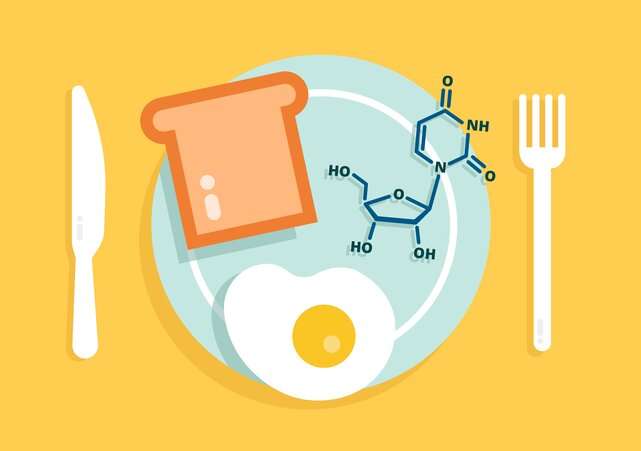This article has been reviewed according to Science X's editorial process and policies. Editors have highlighted the following attributes while ensuring the content's credibility:
fact-checked
peer-reviewed publication
trusted source
proofread
Cells can use uridine, a component of RNA, as a source of energy

Our bodies burn carbohydrates, proteins, and fat for fuel, and now, researchers at the Broad Institute of MIT and Harvard and the University of Lausanne have discovered another important energy source for cells: uridine, the chemical building block unique to RNA.
Their new findings reveal that cells ranging from healthy immune cells to cancer cells can process uridine from RNA like they do with sugar to sustain growth when glucose is limited. Previous research has shown that a diet rich in uridine leads to obesity and pre-diabetes in mice, but scientists didn't know if or how cells convert RNA into ATP, the molecule cells burn for energy.
In a study published today in Nature Metabolism, the research team pinpointed a biochemical pathway that cells use to break down uridine-derived sugar that they then burn for energy. The researchers say that targeting this pathway could potentially help treat cancers and metabolic disorders such as diabetes, and could help tune the immune response.
The findings are from a team including co-senior authors Alexis Jourdain, an assistant professor at the University of Lausanne in Switzerland; and Vamsi Mootha, an institute member at the Broad, a professor of systems biology and medicine at Harvard Medical School, and a professor of molecular biology at Massachusetts General Hospital; as well as co-first authors Owen Skinner, a postdoctoral fellow in Mootha's lab, and Joan Blanco-Fernández, a Ph.D. student in Jourdain's lab.
"Living organisms are packed with RNA, generally in the form of ribosomes, and therefore uridine," said Jourdain, who was a postdoctoral fellow in Mootha's lab when the study began. "You can eat a low-carb diet, but as long as there is RNA in your food, your body is able to convert that RNA into sugar."
Uridine as food
As a researcher in Mootha's lab, Jourdain wanted to know which genes and pathways cells might use to stay alive when nutrients are limited. Using a genetic screen, Jourdain and his colleagues found that the expression of two genes, UPP1 and UPP2, dramatically increases the growth of cells in media without glucose. These genes encode enzymes that help break down uridine, and cells expressing UPP1 and UPP2 grew when uridine was their only food source.
Jourdain wondered if cells could also derive uridine from RNA, so he added RNA to a dish of cancer cells in sugar-free media. To his surprise, the cells grew, suggesting they were able to process uridine even when it's part of RNA.
"I remember telling my friends that I did a crazy experiment where I tried to feed cells with RNA," Jourdain remembers. "I did not think this was going to work—I was very surprised to see the cells grow."
To further probe how common the pathway is across cancer types, the team used PRISM, a technology at the Broad that allows for high throughput screening of hundreds of human cancer cell lines. Together with David Fisher's team at Harvard Medical School, they found that glycolysis from uridine is especially prominent in melanoma, but also occurs in other cancers.
The scientists also showed that this process occurs in immune cells, where uridine may help sustain the immune response by providing energy to cells. Gene expression patterns documented by other researchers suggest the pathway likely occurs in blood cells, the lungs, brain, and kidneys.
Though glycolysis from RNA and uridine is widespread, it is not regulated by the cell, which could have important implications in metabolic diseases. This lack of regulation means that cells continue to burn RNA or uridine even when they don't need energy, and could help explain why diets high in uridine are associated with obesity, fatty liver disease, and pre-diabetes in mice.
Harnessing glycolysis from uridine
Jourdain sees a range of ways to exploit this pathway for therapeutic purposes. Scientists could inhibit the pathway in cancers to starve them, or dial back the activity of overactive immune cells in autoimmune disorders. Conversely, they could promote the pathway to boost immune cells that fight pathogens.
Jourdain's lab is now working to find inhibitors of the pathway and their physiology in animal models. Ultimately, they'd also like to study the effects of RNA-rich foods on obesity in humans.
"We've been underestimating how much energy we can get from eating nucleotides," Jourdain said. "This is really a new player in the field of metabolism and nutrition."
More information: Owen S. Skinner et al, Salvage of ribose from uridine or RNA supports glycolysis in nutrient-limited conditions, Nature Metabolism (2023). DOI: 10.1038/s42255-023-00774-2



















